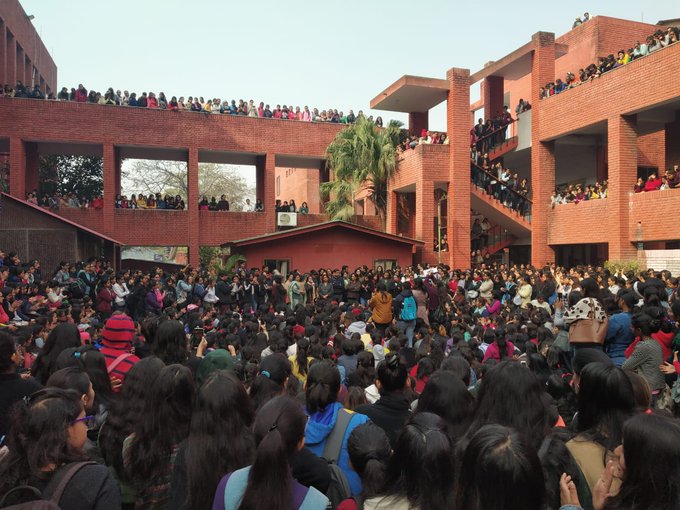
The recent reports from Delhi University’s Gargi College remind us of the significance of rethinking the toxic culture of masculinity, objectification of women and a greater cultural decadence of our times.The college festival ‘Reverie’ was marred by the unruly behaviour of over one hundred middle-aged men who climbed over the walls and fence to gatecrash into the event. All of them were allegedly intoxicated. Women students complained of being groped, molested and masturbated at while the security as well as police officials, much alike during the violence in JNU, looked on and did nothing. Women ran helter-skelter to hide and protect themselves. A major reason why the attacks have sparked outrage is the nonchalant attitude of the administration and inaction of the police forces.
No longer safe
It must be noted that Gargi college is an all-women college. It is evident that this mass molestation was pre-meditated. It is highly shameful that all women campuses are also not safe anymore. Can women ever feel safe and secure in any location? Why is Delhi legitimizing its tag of ‘rape capital’ by such repeated incidents? More importantly, is there a pattern in the inaction of all the three bodies – university/college administration, security force, and police? What is this new trend of standing and watching?
Why is such violence coming to be increasingly normalized? Yes, FIRs have been filed, summons have been sent. But why are such incidents occurring regularly and repeatedly? Why have men become so desensitized, misogynist and violent? What is driving them to such heinous actions? Why is the state unable to control crime of this kind? What is wrong with us and our conscience?
Masculinity at its worse
This incident also brings forth the disease of substance abuse that youth in particular are suffering from. All the molesters had either consumed alcohol, smoked marijuana, or both. Is being intoxicated a license for molestation, sexual abuse or rape? Is this the worst of brute masculinity that we are seeing? Is being male all about pampering one’s fragile ego by using force against women?
While we raise our children, are we making our boys sensitive enough to respect women and their agency? We teach them that boys don’t cry; but do we also go a step further and tell them that boys also do not force girls to cry? Do we make them understand that they do not have any right over anybody else’s body? Do we covertly or overtly tell them that it is okay for them to be violent; it is okay to hit or harm others? Are we not responsible for the transition from boyhood to adulthood culminating into toxic masculinity?
Moral degradation
While we look at these ugly interactions between the opposite sexes, we need to also think about the very nature of college festivals. Is the idea of a college celebration merely about drinks, dance and loud music? Why can we not come up with an alternative conception of festivals wherein we celebrate the aesthetics of art, theater, music, and life itself? Why are our college festivals so identical to ‘Student of The Year’ college events, thanks to Bollywood? Why this mass corporatization, sponsorship and techno-managerial approaches to organizing student events? Why not organize festivals as a celebration of togetherness through creativity, innovation and imagination? Crime and violence aside, our own mass consumption culture has led to the collective decadence of our youth and studentship. On the one hand is the violence of the perpetrator. On the other is the symbolic violence of the erosion of our morals, ethics, and culture.
The state and its institutions must answer why they have failed to protect women and make them feel safe in their own spaces. At the same time, we all need to remember that the perpetrators are not outsiders so to say; they come from among us. An anti-women culture begins from the family and home where women are not cared for and respected. It spreads to the colony, street, society and country. For now, it seems that governments and police need gender sensitization lessons before the perpetrators.













